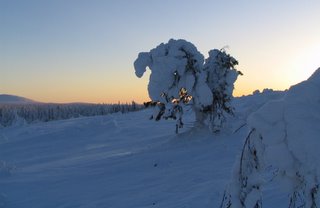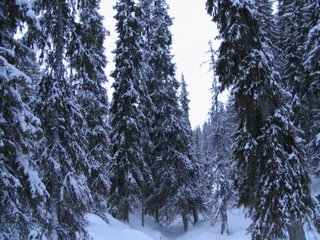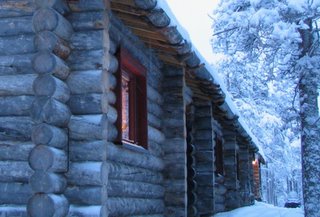Tuesday, January 31, 2006
Urosmetso Kotovaarassa - Male capercaillie in Kotovaara hill
 Urosmetso tuli tarkistamaan Kotovaaran Smear-aseman toimintaa.
Urosmetso tuli tarkistamaan Kotovaaran Smear-aseman toimintaa.Male capercaillie (Tetrao urogallus) came to check the Smear - station in Kotovaara hill
Monday, January 30, 2006
Värriö ykkönen Rakitsalta - Varrio one from Rakitsa hill
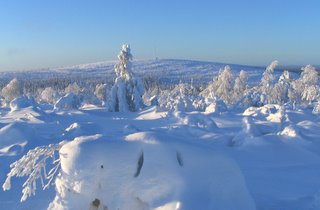 Maanantaina ilma kirkastui edelleen, ja kylmeni samalla. Tykyn voima on edelleen ankara. Kuvassa Rakitsan tunturikoivuja tykyn alla, taustalla Värriö ykkönen.
Maanantaina ilma kirkastui edelleen, ja kylmeni samalla. Tykyn voima on edelleen ankara. Kuvassa Rakitsan tunturikoivuja tykyn alla, taustalla Värriö ykkönen.Sunday, January 29, 2006
Ensimmäinen haukkahavainto - First hawk observation
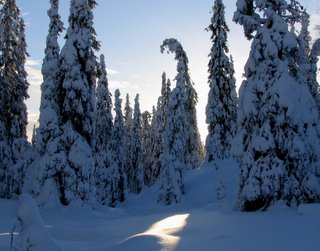 Sunnuntaina taivas selkeni ja tammikuun lopun aurinko helotti. Vastavalossa Rakitsan kurua hiihtäessäni kuusikon lomitse Rakitsalta Värriö ykkösen suuntaan lensi haukka, joka silhuetista päätellen oli kanahaukka - tai sitten tunturihaukka. Kuusikon takaa lähti myöhemmin pyy; haukka lienee ollut pyytä etsimässä.
Sunnuntaina taivas selkeni ja tammikuun lopun aurinko helotti. Vastavalossa Rakitsan kurua hiihtäessäni kuusikon lomitse Rakitsalta Värriö ykkösen suuntaan lensi haukka, joka silhuetista päätellen oli kanahaukka - tai sitten tunturihaukka. Kuusikon takaa lähti myöhemmin pyy; haukka lienee ollut pyytä etsimässä.Saturday, January 28, 2006
Tykkykuusikkoa Rakitsan jängän takana - Candle spruces behind Rakitsa mire
 Tammikuun tykkykuvia: kynttiläkuusia Rakitsan jängän takana.
Tammikuun tykkykuvia: kynttiläkuusia Rakitsan jängän takana.January snow photos: candle spruces (Picea abies) behind Rakitsa mire
Friday, January 27, 2006
Sauoiva tammikuussa - Sauoiva in January

Tammikuun pakkasjakson jälkeen taivas vetäytyi pilveen, yleisväri sininen palasi maisemaan.
After the severe frost season of January the sky bace overcast by the clouds. The common winter color: blueish returned to the scenery.
Thursday, January 26, 2006
Tykyn tuhoja SMEAR -metsässä - Snow damage in SMEAR forest
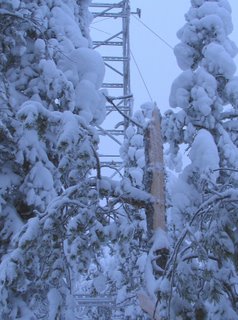 Tammikuun tykkykausi on katkonut nuoria mäntyjä kaikkialla Pohjois-Suomessa. SMEAR -mittausmetsässä Kotovaarassa tuhot jäivät vähäisiksi, vain kolme mäntyä on katkennut. Fotosynteesin mittaus voi jatkua lumien sulattua.
Tammikuun tykkykausi on katkonut nuoria mäntyjä kaikkialla Pohjois-Suomessa. SMEAR -mittausmetsässä Kotovaarassa tuhot jäivät vähäisiksi, vain kolme mäntyä on katkennut. Fotosynteesin mittaus voi jatkua lumien sulattua.The heavy snow period in January has broken young Scots pines everywhere in Northern Finland. In the SMEAR research forest of Kotovaara hill the damage was low. Only three pines were totally broken in the stem. The photosynthesis monitoring may continue in the spring.
Wednesday, January 25, 2006
Elämää talviluonnossa Life in wintertime nature
Itä-Lapin erämaan keskitalvi on hyvin, hyvin hiljaista aikaa. Onko luonnossa elämää ollenkaan? Kirjataanpa havaintoja:
Kuivahaaran latvaa pitkin oli saukkopari noussut viime yönä aivan ylös Värriö IV:n länsipuolelle. Saukot olivat kääntyneet takaisin, mutta jääneet jään alle komoon makuulle, koska alempana tuoreita jälkiä ei enää näkynyt.
Tunturin molemmin puolin oli eilen yksinäiset metsot lakimännyissä ruokailemassa, mutta tänään oli molemmilla kaverit. Itäpuolella oli eilen lisäksi metsopari ja yksinäinen lintu. Kaikki siis mustia lintuja, joista kolmella radiolähetin.
Eilen oli minkki kulkenut tunturin länsipuolella ojan vartta alaspäin, ja kaksi urosnäätää sekä kettu pyöriskelleet samoilla seuduilla. Näätä oli kaivanut pyyn jätteitä lumesta, ja myöhemmin yrittänyt pyytää jänistä, laihoin tuloksin. Sama kettu, tai sen lajitoveri kävi näyttäytymässä asemalla muutama ilta sitten.
Tänään löytyi Kuivahaaran latvalta lisäksi merkkejä urpiaisparvesta; siemeniä ja jalanjälkiä koivun alla. Iltapäivällä aseman ohi lensi isokäpylintuparvi, äänistä päätellen. Viherpeipot ovat asemalla edelleen hengissä, ruokinnan avulla selvinneet. Lisäksi näkee kuukkeleita, korppeja, hömö- ja lapintinttejä, riekkoja, varmaan alamaista löytyisi teeriä ja käpytikkojakin.
Poromiehet olivat löytäneet muiden muassa muutamia kadoksissa olleita härkiään, ja nähneet toistakymmentä hirveä vähän kauempana. Oravan, kärpän, lumikon ja myyrien jälkiä näkee hangella harvakseltaan.
Kaiken kaikkiaan, korpimaan ankara talvi elättää koko joukon erilaisia piipertäjiä. TH
The nature of eastern Lapland is very, very silent in the middle of winter. Is there any life at all? Let us denote some observations.
A pair of otters (Lutra lutra) had risen by the upper course of the river Kuivahaara to the end, and turned downwards last night. They had stayed for the day somewhere under the ice, because I didn't find their fresh tracks farther down.
On both sides of the fell I saw a lonely capercaillie (Tetrao urogallus) yesterday, browsing in the pines. Today they both had got friends. Also, on the east side yesterday there were one pair and a lonely one. All the birds were black (males), tree of them with radio transmitters.
On the western side yesterday a mink (Mustela vison) had gone downwards by a little creek, and two male pine martens (Martes martes) and fox (Vulpes vulpes) had cruised on this territory. One marten had digged up remains of a hazel hen (Tetrastes bonasia) from the snow, and later it had tried to catch a hare (Lepus timidus), with poor result. The same fox, or its species mate, was seen at the station a couple of nights ago.
On the upper course of Kuivahaara I found marks of a flock of redpoll (Carduelis flammea); seeds and footprints under a birch. In the afternoon a flock of pine crossbills (Loxia pytyopsittacus) flew over the station, I identifeid them by their voices. Greenfinches (Carduelis chloris) have survived, thanks to feeding, by the station. Also we can see ravens (Corvus corax), siberian jays (Perisoreus infaustus) and siberian tits (Parus cinctus), willow tits (Parus montanus) and willow ptarmigans (Lagopus lagopus). On the lower areas one surely can find also great spotted woodpeckers (Dendrocopos major) and black grouses (Lyrurus tetrix).
The reindeer herdsmen had found a couple of oxes, the castrated reindeer ones, among others (Rangifer tarandus). They had seen over ten couples of mouses (Alces alces), too. In addition to this, one can see tracks of squirrels (Sciurus vulgaris), ermins (Mustela erminea), small weasels (Mustela rixosa), voles, here and there in the snow.
All in all, despite the severe winter the wilderness feeds a whole lot of various trippers.
Середина зимы в Восточной Лапландий очень, очень тихо. Существует ли там жизннь? Давайте пишем наблюдения:
Пара выдр поднялась вверх по верховью реки Куивахаара до самого конца на западной стороне Вярриё IV, и потом повернулись назад. Но они остались отдыхать там где-то подо льдом, потому что ниже по реке больше свежих следов я не видел.
На обоих сторонах тундры были одинокие глухары вчера, но сегодня они получили дружей к себе. Еще на восточной стороне были одна пара и одинокий. Они все были черные птицы, три из них с радиопередатчиками.
Вчера ходила норка по маленькому ручею на западной стороне тундры, и двух самца лесных куниц и лиса кружились на той же территорий. Один из куниц выкопал остатки рябчика из-под снега, и потом он постарался поймать зайца, но с плохым ресультатом. Эта лиса, или другой представитель этого вида была видна на станций несколько вечеров тому назад.
На верховье реки Куивахаара я нашел знаки чечеток сегодня; семи и следы птиц под березой. Во второй половине дня стая клестов-сосновиков пролетела мимо станций, судил по звукам я. Пара зеленушки по-видимому выживет у станций, так как кормят их. Еще можно видеть воронов, кукш, буро- и сероголовых гайчек, белых куропаток. На нижных ареалах можно видеть и большых дятелей и тетеревов.
Оленеводы нашли несколько волов, значит покастрированных оленей, среди других. Они тоже видели больше десяти лосей, немножко дальше от станций. Мимо всего этого видны тут следы белки, горностая, ласки, полевок, немногочисленно на снегу.
В конце концов, суровая зима глухомани содержит целую группу различных обитателей.
Kuivahaaran latvaa pitkin oli saukkopari noussut viime yönä aivan ylös Värriö IV:n länsipuolelle. Saukot olivat kääntyneet takaisin, mutta jääneet jään alle komoon makuulle, koska alempana tuoreita jälkiä ei enää näkynyt.
Tunturin molemmin puolin oli eilen yksinäiset metsot lakimännyissä ruokailemassa, mutta tänään oli molemmilla kaverit. Itäpuolella oli eilen lisäksi metsopari ja yksinäinen lintu. Kaikki siis mustia lintuja, joista kolmella radiolähetin.
Eilen oli minkki kulkenut tunturin länsipuolella ojan vartta alaspäin, ja kaksi urosnäätää sekä kettu pyöriskelleet samoilla seuduilla. Näätä oli kaivanut pyyn jätteitä lumesta, ja myöhemmin yrittänyt pyytää jänistä, laihoin tuloksin. Sama kettu, tai sen lajitoveri kävi näyttäytymässä asemalla muutama ilta sitten.
Tänään löytyi Kuivahaaran latvalta lisäksi merkkejä urpiaisparvesta; siemeniä ja jalanjälkiä koivun alla. Iltapäivällä aseman ohi lensi isokäpylintuparvi, äänistä päätellen. Viherpeipot ovat asemalla edelleen hengissä, ruokinnan avulla selvinneet. Lisäksi näkee kuukkeleita, korppeja, hömö- ja lapintinttejä, riekkoja, varmaan alamaista löytyisi teeriä ja käpytikkojakin.
Poromiehet olivat löytäneet muiden muassa muutamia kadoksissa olleita härkiään, ja nähneet toistakymmentä hirveä vähän kauempana. Oravan, kärpän, lumikon ja myyrien jälkiä näkee hangella harvakseltaan.
Kaiken kaikkiaan, korpimaan ankara talvi elättää koko joukon erilaisia piipertäjiä. TH
The nature of eastern Lapland is very, very silent in the middle of winter. Is there any life at all? Let us denote some observations.
A pair of otters (Lutra lutra) had risen by the upper course of the river Kuivahaara to the end, and turned downwards last night. They had stayed for the day somewhere under the ice, because I didn't find their fresh tracks farther down.
On both sides of the fell I saw a lonely capercaillie (Tetrao urogallus) yesterday, browsing in the pines. Today they both had got friends. Also, on the east side yesterday there were one pair and a lonely one. All the birds were black (males), tree of them with radio transmitters.
On the western side yesterday a mink (Mustela vison) had gone downwards by a little creek, and two male pine martens (Martes martes) and fox (Vulpes vulpes) had cruised on this territory. One marten had digged up remains of a hazel hen (Tetrastes bonasia) from the snow, and later it had tried to catch a hare (Lepus timidus), with poor result. The same fox, or its species mate, was seen at the station a couple of nights ago.
On the upper course of Kuivahaara I found marks of a flock of redpoll (Carduelis flammea); seeds and footprints under a birch. In the afternoon a flock of pine crossbills (Loxia pytyopsittacus) flew over the station, I identifeid them by their voices. Greenfinches (Carduelis chloris) have survived, thanks to feeding, by the station. Also we can see ravens (Corvus corax), siberian jays (Perisoreus infaustus) and siberian tits (Parus cinctus), willow tits (Parus montanus) and willow ptarmigans (Lagopus lagopus). On the lower areas one surely can find also great spotted woodpeckers (Dendrocopos major) and black grouses (Lyrurus tetrix).
The reindeer herdsmen had found a couple of oxes, the castrated reindeer ones, among others (Rangifer tarandus). They had seen over ten couples of mouses (Alces alces), too. In addition to this, one can see tracks of squirrels (Sciurus vulgaris), ermins (Mustela erminea), small weasels (Mustela rixosa), voles, here and there in the snow.
All in all, despite the severe winter the wilderness feeds a whole lot of various trippers.
Середина зимы в Восточной Лапландий очень, очень тихо. Существует ли там жизннь? Давайте пишем наблюдения:
Пара выдр поднялась вверх по верховью реки Куивахаара до самого конца на западной стороне Вярриё IV, и потом повернулись назад. Но они остались отдыхать там где-то подо льдом, потому что ниже по реке больше свежих следов я не видел.
На обоих сторонах тундры были одинокие глухары вчера, но сегодня они получили дружей к себе. Еще на восточной стороне были одна пара и одинокий. Они все были черные птицы, три из них с радиопередатчиками.
Вчера ходила норка по маленькому ручею на западной стороне тундры, и двух самца лесных куниц и лиса кружились на той же территорий. Один из куниц выкопал остатки рябчика из-под снега, и потом он постарался поймать зайца, но с плохым ресультатом. Эта лиса, или другой представитель этого вида была видна на станций несколько вечеров тому назад.
На верховье реки Куивахаара я нашел знаки чечеток сегодня; семи и следы птиц под березой. Во второй половине дня стая клестов-сосновиков пролетела мимо станций, судил по звукам я. Пара зеленушки по-видимому выживет у станций, так как кормят их. Еще можно видеть воронов, кукш, буро- и сероголовых гайчек, белых куропаток. На нижных ареалах можно видеть и большых дятелей и тетеревов.
Оленеводы нашли несколько волов, значит покастрированных оленей, среди других. Они тоже видели больше десяти лосей, немножко дальше от станций. Мимо всего этого видны тут следы белки, горностая, ласки, полевок, немногочисленно на снегу.
В конце концов, суровая зима глухомани содержит целую группу различных обитателей.
Tuesday, January 24, 2006
Jäniksen jäljet Värriö ykkösellä
Monday, January 23, 2006
Värriössä pakkasjakso 16.-22. tammikuuta - Heavy frost season in Varrio 16.-22. January
Värriö kuten muu Lappi ja koko Suomi kokivat pakkasjakson tammikuussa. Sen käynnisti vahva korkeapaine Venäjällä. Se aiheutti aluksi voimakkaan itä-kaakkoisvirtauksen, joka toi kylmän ilmamassan Suomen päälle. Vähitellen tuuli tyyntyi, ja kun ilma pysyi kirkkaana yötä päivää, jo valmiiksi kylmennyt ilmamassa alkoi jäähtyä pitkäaaltoisen ulossäteilyn myötä. Pakkanen kiristyi päivä päivältä, kunnes lännestä tullut matalapaine ja sen pilvet lauhduttivat ilman.
Vuoden 2006 alin lämpötila -30.5 mitattiin 22.01.2006. Värriön säätietokannassa 1975-2006 päivä sijoittuu kylmyyslistalla sijalle 12.
Värriön tutkimusaseman kylmin, vastaavan tyyppinen jakso on koettu tammikuussa 1999. Kolme kylmintä päivää olivat
-38.3 pvm 26.01.1999
-37.4 pvm 27.01.1999
-34.7 pvm 25.01.1999
Edellinen Värriön kylmyysennätys oli -32.0 pvm 08.01.1987
Värriön tutkimusasemalla säätä havainnoi Ilmatieteen laitoksen automaattinen sähköinen laitteisto. Sen lisäksi sää havainnoidaan kolmesti päivässä miestyönä. Lämpötila havainnoidaan sekä hetkittäisinä havaintoina että minimilämpötilan mittauksina kahden metrin korkeudella ja maan pinnassa. Kylmimmät lämpötilat mitataan jokseenkin säännöllisesti maan pinnassa. Seuraavien päivien pakkaslukemat ovat maan pinnasta ellei toisin ole mainittu.
Vuoden 2006 alin lämpötila -30.5 mitattiin 22.01.2006. Värriön säätietokannassa 1975-2006 päivä sijoittuu kylmyyslistalla sijalle 12.
Värriön tutkimusaseman kylmin, vastaavan tyyppinen jakso on koettu tammikuussa 1999. Kolme kylmintä päivää olivat
-38.3 pvm 26.01.1999
-37.4 pvm 27.01.1999
-34.7 pvm 25.01.1999
Edellinen Värriön kylmyysennätys oli -32.0 pvm 08.01.1987
Värriön tutkimusasemalla säätä havainnoi Ilmatieteen laitoksen automaattinen sähköinen laitteisto. Sen lisäksi sää havainnoidaan kolmesti päivässä miestyönä. Lämpötila havainnoidaan sekä hetkittäisinä havaintoina että minimilämpötilan mittauksina kahden metrin korkeudella ja maan pinnassa. Kylmimmät lämpötilat mitataan jokseenkin säännöllisesti maan pinnassa. Seuraavien päivien pakkaslukemat ovat maan pinnasta ellei toisin ole mainittu.
Pakkaskausi ohi, tunturi vetäytyy pilveen - Frost season is over, clouds start to cover the sky
 Maanantaina pakkaskausi oli ohi, Värriötunturit vetäytyvät pilveen.
Maanantaina pakkaskausi oli ohi, Värriötunturit vetäytyvät pilveen.Vuorokauden minimilämpötila -17.8 astetta.
Sunday, January 22, 2006
Jakson kylmin päivä - Coldest day during this period
Saturday, January 21, 2006
Juuoiva pakkasessa - Juuoiva on frosty day
 Lauantaina vuorokauden keskilämpötila oli -28.9 astetta. Koska pakkanen laski koko päivän tämä lukema mitattiin illan suussa minimilämpötilana kahden metrin korkeudella.
Lauantaina vuorokauden keskilämpötila oli -28.9 astetta. Koska pakkanen laski koko päivän tämä lukema mitattiin illan suussa minimilämpötilana kahden metrin korkeudella.Näkyvyys pakkasilmassa edelleen hyvä. Kuvassa on Juuoivan tunturiketju, Venäjän puolella.
Friday, January 20, 2006
Tykyn uuvuttama kuusi Värriö ykkösellä - Norway spruce pressed by heavy snow on Varrio one
 Perjantain minimilämpötila oli -27.5 astetta.
Perjantain minimilämpötila oli -27.5 astetta.Kuvan tykyn painama kuusi kasvaa Värriö ykkösen koillisrinteellä, taustalla Rakitsan vaara.
Thursday, January 19, 2006
Pakolainen pakkasessa - Fugitive in the frost
Ajaessani autolla 19.01.06 klo 13 maissa Sotajoen E-puolella suuntaan E, tuli oikean puolen ravia pitkin 2-3 m korkeudessa lintu, joka ensi näkemältä vaikutti pikkuhaukalta. Lähellä huomasin sillä pitkän, ohuen nokan, levitetyt pyrstösulat ja värisevät siivet. Mielessäni välähti - merisirri! Pysähdyin, ja etsin lintua, autolla jopa parin kilometrin päästä, mutta en löytänyt.
Lintu lensi kahlaajamaisesti räpyttäen, kuin rantasipi. Ainoa mahdollisuus taitaa olla merisirri (Calidris maritima), vaikka tarkasti en lintua tunnistanutkaan. Muita pieniä kahlaajalajeja ei jää pohjoiseen yleensä talvehtimaan. Muunlainen lintu, esim. tikka, se ei ollut. Ilmeisesti viime päivien hirmupakkaset ovat ajaneet lauhan alkutalven ansiosta Vienan - Jäämerelle talvehtimaan jääneet merisirrit pakosalle. Linnun lentosuunta oli W ja pakkasta 30 astetta. TH
When I drove by car on 19.01.06 at 13. o'clock to the east on the eastern side of the river Sotajoki, a bird was flying against me on the right side of the road, 2-3 m above the gutter. The bird seemed to be a little hawk, but nearer I saw his long, tiny bill, spreaded feathers of tail and shivering wings. I got like a gleam - purple sandpiper! I stopped, and searched the bird, even to two kilometres of the place, but couldn't find him.
The bird flew like wading birds - flapping the wings like sandpipers. Perhaps the only possible alternative is purple sandpiper (Calidris maritima), although I couldn't recognize the bird accurately. The other little sandpipers don't generally stay in the north for winter. No other type of bird he couldn't be, like for ex. woodpecker. Obviously the last cold days had effect, that the purple sandpipers, which stayed on the coasts of the White Sea - Arctic Ocean because of the mild early winter, had to become fugitives. The bird was flying to the west, and temperature was 30 degrees below zero. TH
Когда я ездил на машине 19.01.06 в 13. ч. на восток на восточной стороне реки Сотайоки, я увидел птицу, летающую прямо на меня на правой стороне дороги, в высоте 2-3 м над канавой. Мне казалось, что это был маленкий сокол, но когда она пришла ближе, я заметил ее длинный, тонкий клюв, раскрытый хвост и трясшиеся крылья. Тогда у меня как будто блеснула мысль - морской песочник! Я остановился, и искал птицу, даже на расстоянии двух километра назад, но не нашел.
Птица летал как кулики, как перевозчик, взмахивая крыльями. Кажется, что единственный вариант - морской песочник, хотя я точно его не определил. Другие маленкие кулики вообще не остаются на севере зимовать. А никакой другой тип птицы она не могла быть, как например дятель. Очевидно, что лютие морозы прошлих дней выгнали в бегство морских песочников, которие остались зимовать из-за мягкого начала зимы на берегах Белого моря - Ледовитого океана. Направление полета у птицы было на запад, и температура воздуха была 30 градусов.
Lintu lensi kahlaajamaisesti räpyttäen, kuin rantasipi. Ainoa mahdollisuus taitaa olla merisirri (Calidris maritima), vaikka tarkasti en lintua tunnistanutkaan. Muita pieniä kahlaajalajeja ei jää pohjoiseen yleensä talvehtimaan. Muunlainen lintu, esim. tikka, se ei ollut. Ilmeisesti viime päivien hirmupakkaset ovat ajaneet lauhan alkutalven ansiosta Vienan - Jäämerelle talvehtimaan jääneet merisirrit pakosalle. Linnun lentosuunta oli W ja pakkasta 30 astetta. TH
When I drove by car on 19.01.06 at 13. o'clock to the east on the eastern side of the river Sotajoki, a bird was flying against me on the right side of the road, 2-3 m above the gutter. The bird seemed to be a little hawk, but nearer I saw his long, tiny bill, spreaded feathers of tail and shivering wings. I got like a gleam - purple sandpiper! I stopped, and searched the bird, even to two kilometres of the place, but couldn't find him.
The bird flew like wading birds - flapping the wings like sandpipers. Perhaps the only possible alternative is purple sandpiper (Calidris maritima), although I couldn't recognize the bird accurately. The other little sandpipers don't generally stay in the north for winter. No other type of bird he couldn't be, like for ex. woodpecker. Obviously the last cold days had effect, that the purple sandpipers, which stayed on the coasts of the White Sea - Arctic Ocean because of the mild early winter, had to become fugitives. The bird was flying to the west, and temperature was 30 degrees below zero. TH
Когда я ездил на машине 19.01.06 в 13. ч. на восток на восточной стороне реки Сотайоки, я увидел птицу, летающую прямо на меня на правой стороне дороги, в высоте 2-3 м над канавой. Мне казалось, что это был маленкий сокол, но когда она пришла ближе, я заметил ее длинный, тонкий клюв, раскрытый хвост и трясшиеся крылья. Тогда у меня как будто блеснула мысль - морской песочник! Я остановился, и искал птицу, даже на расстоянии двух километра назад, но не нашел.
Птица летал как кулики, как перевозчик, взмахивая крыльями. Кажется, что единственный вариант - морской песочник, хотя я точно его не определил. Другие маленкие кулики вообще не остаются на севере зимовать. А никакой другой тип птицы она не могла быть, как например дятель. Очевидно, что лютие морозы прошлих дней выгнали в бегство морских песочников, которие остались зимовать из-за мягкого начала зимы на берегах Белого моря - Ледовитого океана. Направление полета у птицы было на запад, и температура воздуха была 30 градусов.
Kaakkoisvinkka pudottaa lämpötilaa - Strong south-eastern wind drops the temperature
 Vuorokauden minimilämpötila -25.3 astetta.
Vuorokauden minimilämpötila -25.3 astetta.Kaakosta puhaltava tuuli pudottaa lämpötilaa. Lumi pöllyää Värriö ykkösellä.
Wednesday, January 18, 2006
Pakkanen alkoi kiristyä - Frost goes deeper
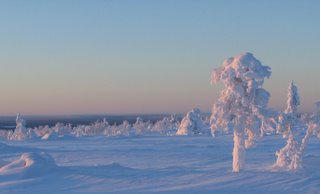 Jo pari vuorokautta Itä-Lappiin on virrannut kylmää itäistä ilmaa. Lämpötilan laskemisen näkee myös taivaan väreistä. Kuva Värriö ykköseltä.
Jo pari vuorokautta Itä-Lappiin on virrannut kylmää itäistä ilmaa. Lämpötilan laskemisen näkee myös taivaan väreistä. Kuva Värriö ykköseltä.Vuorokauden minimilämpötila -26.5 astetta.
Tuesday, January 17, 2006
Saariselkä horisontissa - Saariselka fell range in horizon
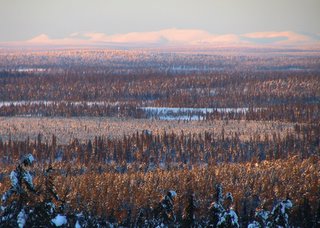 Vuorokauden minimilämpötila -21.5 astetta mitattiin vasta illansuussa, koska lämpötila oli jatkuvassa laskussa.
Vuorokauden minimilämpötila -21.5 astetta mitattiin vasta illansuussa, koska lämpötila oli jatkuvassa laskussa. Kylmän, itä-kaakosta puhaltavan tuulen mukana Venäjän puolelta, alunperin Siperiasta virtaa äärimmäisen kuivaa ja puhdasta ilmaa. Aurinkoisena pakkaspäivänä näkyvyys on ennätyksellisen hyvä, sillä kylmä ilma ei myöskään väreile.
Värriö ykköseltä näkyy luoteessa koko Saariselän massiivi. Äärimmäisenä vasemmalla Sokostin jyrkkä lounaisrinne.
Monday, January 16, 2006
Poroja pakkasessa Värriö ykkösellä - Reindeers grazing on Varrio one
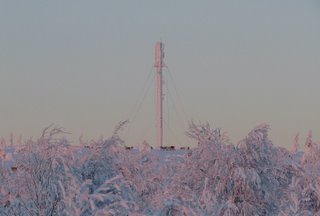 Vuorokauden minimilämpötila -15.3 astetta, mitattu illan suussa, lämpötilan laskiessa koko ajan.
Vuorokauden minimilämpötila -15.3 astetta, mitattu illan suussa, lämpötilan laskiessa koko ajan.Sallan pohjoisen paliskunnan porot nousevat ylämaihin, Värriötuntureille paksun lumen aikaan. Kovakaan pakkanen ei aja poroja pois tunturista.
Reindeers like to graze on the slopes of Varrio fells during the thick snow. Even freezing temperatures do not drive the animals away from the fell.
Sunday, January 15, 2006
Tammiaurinko nousee - January sun rises
 Tammikuun puolenvälin aurinko nousee Värriö kakkosen takaa. Etualalla porojen kaivuuta Värriö ykkösen kaakkoisrinteessä.
Tammikuun puolenvälin aurinko nousee Värriö kakkosen takaa. Etualalla porojen kaivuuta Värriö ykkösen kaakkoisrinteessä.The sun is rising in the middle of January behind Varrio two. In the front reindeers have dug lichens through the snow. The photo is taken on the south-eastern slopw of Varrio one.
Saturday, January 14, 2006
Pirunkuru varjossa - Devil's creek in shade
 Pirunkurun kuusikkoon tammiaurinko ei vielä yllä.
Pirunkurun kuusikkoon tammiaurinko ei vielä yllä.The spruces at the bottom of Devil's creek cannot enjoy the January sun yet.
Friday, January 13, 2006
Korvatunturi tammiauringossa - Korvatunturi fell in January sun
 Kirkkaana päivänä Korvatunturin kolmihuippuinen silhuetti erottuu tammiauringossa selvästi. Oikean puolimmaisen huipun takana häämöttää Venäjän puolen tunturi, joka kuuluu Joutsenpäihin. Kuva Värriö ykköseltä pohjoiseen.
Kirkkaana päivänä Korvatunturin kolmihuippuinen silhuetti erottuu tammiauringossa selvästi. Oikean puolimmaisen huipun takana häämöttää Venäjän puolen tunturi, joka kuuluu Joutsenpäihin. Kuva Värriö ykköseltä pohjoiseen.On a clear january day the three-peaked top of Korvatunturi fell - the mythical home of Santa Claus - is clearly seen from Varrio one.
Thursday, January 12, 2006
Nuorttitunturin poroaita tammiauringossa - Reindeer fence of Nuortti fell in January sun
 Tammiauringossa, paksun tykkylumen aikaan myös Nuorttitunturin poroaita erottuu selvästi.
Tammiauringossa, paksun tykkylumen aikaan myös Nuorttitunturin poroaita erottuu selvästi.In the January sun, under heavy snow burden, also the reindeer fence of Nuortti fell is clearly seen.
Wednesday, January 11, 2006
Nuorttitunturi tammiauringossa - Nuortti fell in January sun light
 Kun tammiaurinko vihdoin kirkkaana pakkaspäivänä näyttäytyy, se kultaa tunturien laet ensiksi, kuten kuvan Nuorttitunturin.
Kun tammiaurinko vihdoin kirkkaana pakkaspäivänä näyttäytyy, se kultaa tunturien laet ensiksi, kuten kuvan Nuorttitunturin.When the January sun is finally seen, it paints the fell tops with orange light, like the top of Nuortti fell in the photo.
Tuesday, January 10, 2006
Aurinko yrittää nousta - The sun tries to rise
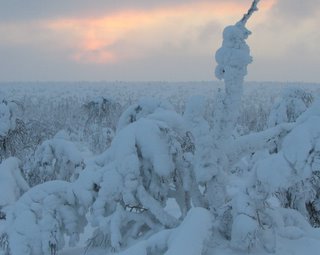 Värriötunturissa auringon ensimmäinen nousupäivä on noin 5. tammikuuta. Ajankohta on usein pilvistä, eikä auringosta vielä näy muuta kuin kajastus pilvien takaa. Kuva Värriö ykköseltä yli Värriö kakkosen.
Värriötunturissa auringon ensimmäinen nousupäivä on noin 5. tammikuuta. Ajankohta on usein pilvistä, eikä auringosta vielä näy muuta kuin kajastus pilvien takaa. Kuva Värriö ykköseltä yli Värriö kakkosen.The first possible day when the sun rises after the Christmas, is around 5 January. Often the sky is overcast by winter clouds and we can see only some penetrating sun light through the clouds. The photo is taken on Varrio I, towarss Varrio II.
Monday, January 09, 2006
Jääpuikkoja tutkimusasemalla - Ice sticks on research station
 Samaa tahtia kuin tykky kerrostuu puihin, lunta kertyy tutkimusaseman katolle. Paljastuu vanhojen puutalojen eristysongelma: taloista on lämpövuotoa katon läpi, lumi sulaa ja sulavesi alkaa jäätyä jääpuikoiksi.
Samaa tahtia kuin tykky kerrostuu puihin, lunta kertyy tutkimusaseman katolle. Paljastuu vanhojen puutalojen eristysongelma: taloista on lämpövuotoa katon läpi, lumi sulaa ja sulavesi alkaa jäätyä jääpuikoiksi.Along with snow deposits on the trees the snow accumulates on the roof. A common phenomenon of old wooden houses emerges. There is a heat leakage through the ceiling to the roof. The snow starts to melt, the water freezes, and hanging ice sticks are seen along the roof.
Sunday, January 08, 2006
Mikä vapautti männyn latvan - Who or which freed the Scots pine top?
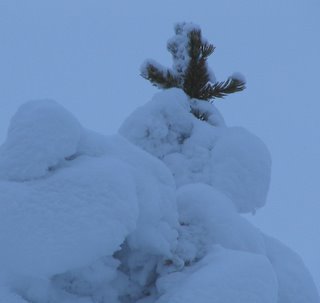 Mikä vapautti tykyn muuten peittämän männyn latvan Värriö ykkösen pohjoisrinteellä? Korppi, käpylintu, vai tuuli vain?
Mikä vapautti tykyn muuten peittämän männyn latvan Värriö ykkösen pohjoisrinteellä? Korppi, käpylintu, vai tuuli vain?Who or which freed the top of Scots pine? Was it raven (Corvus corax) or crossbill (Loxia sp.), or just the wind. The tree is growing on northern slope of Varrio one.
Saturday, January 07, 2006
Tykkymänty koivujen paalla - Lonely Scots pine above the birches
 Yksinäinen mänty tunturikoivujen yläpuolella Värriö ykkösen etelärinteellä, kaikki raskaan tykyn alla.
Yksinäinen mänty tunturikoivujen yläpuolella Värriö ykkösen etelärinteellä, kaikki raskaan tykyn alla.A lonesome Scots pine above mountain birches at the southern slope of Varrio I, all trees under heavy snow burden.
Friday, January 06, 2006
Koivuvyohyke koetuksella - Regio subalpina on challenge
 Värriö ykkösen ja kakkosen välissä oleva koivuvyöhyke (Regio subalpina) on poikkeuksellisen kovalla koetuksella tammikuun 2006 lumitykyn vuoksi. Valtaosa tunturikoivusta kestänee tykyn ilman näkyviä vaurioita. Taustalla Värriö kakkosen pohjoisrinne.
Värriö ykkösen ja kakkosen välissä oleva koivuvyöhyke (Regio subalpina) on poikkeuksellisen kovalla koetuksella tammikuun 2006 lumitykyn vuoksi. Valtaosa tunturikoivusta kestänee tykyn ilman näkyviä vaurioita. Taustalla Värriö kakkosen pohjoisrinne.Regio subalpina between the peaks Varrio one and Varrio two meets an exceptional snow challenge in January 2006. Major part of the mountain birches, however, will pass this period without visible damage. The northern slope of Varrio II in the background.
Thursday, January 05, 2006
Tunturikoivutkin murtuvat - Mountain birches break
 Tammikuun tykky saavutti viimeisen raskausrajan: tunturikoivut alkavat murtua. Kuvan koivu Värriö ykkösen pohjoisrinteellä.
Tammikuun tykky saavutti viimeisen raskausrajan: tunturikoivut alkavat murtua. Kuvan koivu Värriö ykkösen pohjoisrinteellä.The heavy snow burden meets another milestone: the mountain birches start to break in regio subalpina. The photo is taken on the northern slope of Varrio I
Wednesday, January 04, 2006
Tykkyä Itä-lapissa - Heavy snow in Eastern Lapland
 Koko Itä-Lapissa on runsaasti tykkyä tammikuun alussa. Tykkyä kertyy eniten vaaramaihin, joiden puihin alijäähtyneiden pilvien vesi kerrostuu ensin huurteeksi. Kevyesti satava lumi takertuu sen jälkeen puiden huurteeseen ja tykkykuorma alkaa kasvaa.
Koko Itä-Lapissa on runsaasti tykkyä tammikuun alussa. Tykkyä kertyy eniten vaaramaihin, joiden puihin alijäähtyneiden pilvien vesi kerrostuu ensin huurteeksi. Kevyesti satava lumi takertuu sen jälkeen puiden huurteeseen ja tykkykuorma alkaa kasvaa.The whole Eastern Lapland experiences heavy snow burden in the beginning of January. The origin of the snow burden of the trees is in super cool clouds the water of which condenses first in the branches. Next, the slowly falling snow deposits on the branches and tops of the trees. Finally the trees have heavy burdens.
Tuesday, January 03, 2006
Pirunkurun kuusikko - Spruces in Devil's creek
Monday, January 02, 2006
Jyppyrän kallio - Cliff of Jyppyra hill
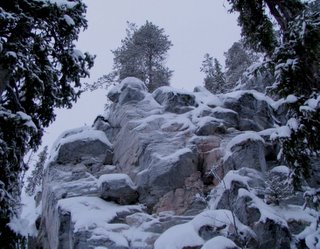 Tammikuun Varriokuvia: Jyppyrävaaran kallio Pirunkurun lammen yläpuolella.
Tammikuun Varriokuvia: Jyppyrävaaran kallio Pirunkurun lammen yläpuolella.January photos od Varrio: Cliff of Jyppyra hill above the pond in Devil's creek.

